Vincent van Gogh arrived in Auvers-sur-Oise, a small town about 30km northwest of Paris, on May 20th, 1890. The painter had suffered four bouts of psychotic depression in the preceding year at an asylum in Saint-Rémy-de-Provence, in southern France. The crises struck with increasing frequency and duration, and Van Gogh lived in terror of their recurrence.
The impressionist painter Camille Pissarro, a friend to Van Gogh and his art-dealer brother, Theo, recommended Dr Paul Gachet in Auvers. Gachet specialised in the illness then known as melancholia.
Van Gogh brought several canvases with him from Saint-Rémy in the hope that they might help Gachet unlock the secret of his illness. His 1889 self-portrait, the penultimate of 35 self-likenesses, was among them. The pale, blue-green self-portrait appears almost phosphorescent and gives the canvas a drowning, subaqueous look. The swirling brushstrokes in the background and on Van Gogh’s clothing increase the impression of troubled water. The artist stares with what the poet Jacques Prévert called “the true look, lucid and mad, of those who give all to life”.
The self-portrait opens a fabulous new exhibition, Van Gogh in Auvers-sur-Oise: The Final Months, at the Musée d’Orsay, in Paris. The show’s curators, Nienke Bakker of the Van Gogh Museum, in Amsterdam, and Emmanuel Coquery of the National Library of France, brought together 40 of the 74 paintings that Van Gogh completed in his last, 70-day burst of creative genius.
“Between the Musée d’Orsay and the Van Gogh Museum we already had about 15 masterpieces, a strong core for the exhibition,” says Coquery. The rest of the works were borrowed from museums and private collections around the world.
Gachet, a friend to Cézanne and Pissarro and himself an amateur painter, was “absolutely fanatical” about Van Gogh’s self-portrait, the artist wrote to Theo. “He wants me to do one of him if I can, absolutely like that.”
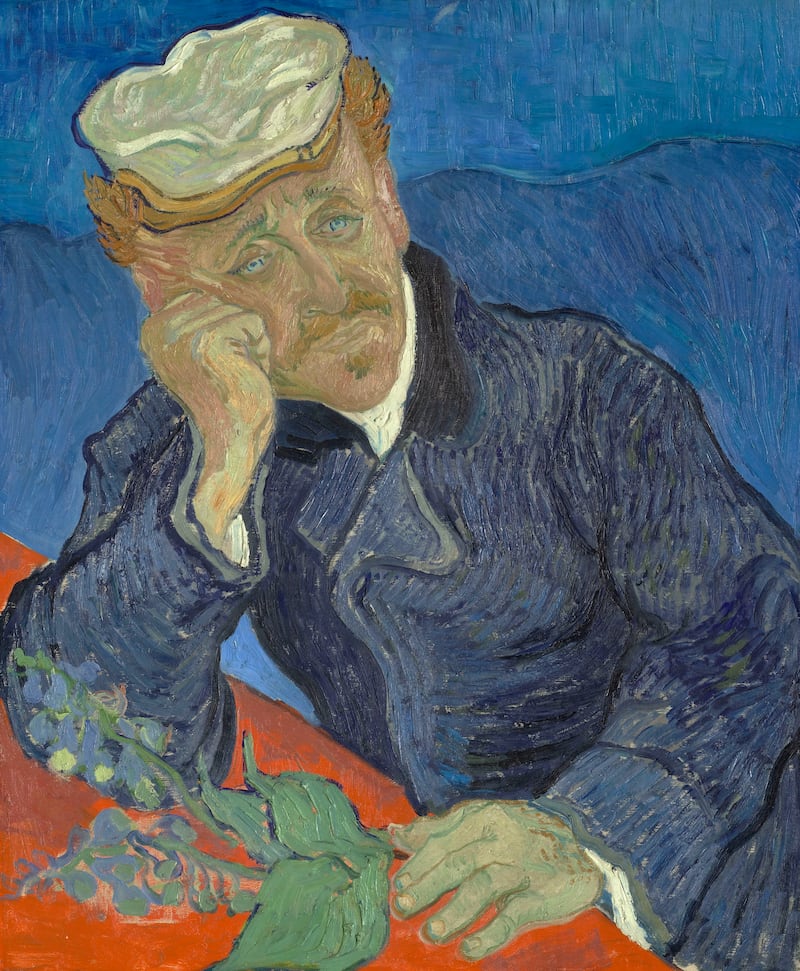
Van Gogh painted Gachet twice; the doctor is leaning on his hand, in a pose symbolising melancholy. Foxgloves, which Gachet used for homeopathy, appear on the table beside him. A widower who never got over the death of his wife, Gachet seemed to Van Gogh “to be suffering at least as seriously as I am”. With his strong nose, blue eyes, ginger hair and sad expression, Gachet is almost a doppelganger of Van Gogh.
Van Gogh’s physical health was nearly as precarious as his mental condition. He was an alcoholic who repeatedly contracted sexually transmitted illnesses. He lost several teeth to decay, had liver and stomach problems, and subsisted mostly on leeks, onions and garlic in the mistaken belief that they were nutritious.
Gachet diagnosed Van Gogh’s mental problems as stemming from an unfounded fear of syphilis. Like so many artists of the period, Van Gogh frequented brothels and may indeed have suffered from the disease.
Van Gogh ignored Gachet’s instructions to stop smoking and drinking but took to heart his advice to immerse himself in work. The artist went out to paint at dawn each morning, then retouched his canvases in the afternoon at the Ravoux Inn, where he rented a room.
Auvers was “seriously beautiful”, Van Gogh wrote to Theo and his bride, Johanna. There was, he added, “a lot of wellbeing in the air”.
Vincent, the older brother by four years, was socially inept and had failed at almost everything he attempted. Theo was charming, intelligent and successful. His parents called them their crown. They worried constantly about Vincent.
Despite their opposite characters and fortunes, the brothers were incredibly close. Without Theo, Vincent could not have become the great artist he was. By 1880 Vincent had botched careers as an art dealer, teacher, preacher and missionary. Theo sparked new enthusiasm in his despairing brother by sending him art manuals and materials.
Until the mid-1880s Van Gogh’s works were proficient but dark and dreary. At Theo’s insistence, he began using bright colours. Theo welcomed Vincent to his Paris apartment from 1886 until 1888, making it possible for Vincent to meet other painters. Theo never lost faith in Vincent’s genius and supported him until his death. Vincent wrote more than 600 letters to Theo over the last 18 years of his life, including 24 from Auvers.
From 1886 on, the brothers corresponded in French. Vincent wanted to be known only as Vincent, dropping his Dutch surname.
Though Van Gogh’s early works documented the misery of the working poor, he came to believe, like Dostoevsky, that beauty could save the world. He saw first religion, then art as a source of consolation. His favourite verse from the Bible, from 2 Corinthians 6:10, was “sorrowful, yet always rejoicing”.
Coquery, the cocurator of the Orsay exhibition, says Van Gogh’s paintings “are not so much joyous as lively. They may be troubled or anxious, but they are not melancholic, not desperate. He uses the metaphor of painting as a lightning rod which channelled the electricity within him, infusing his paintings with animation.”

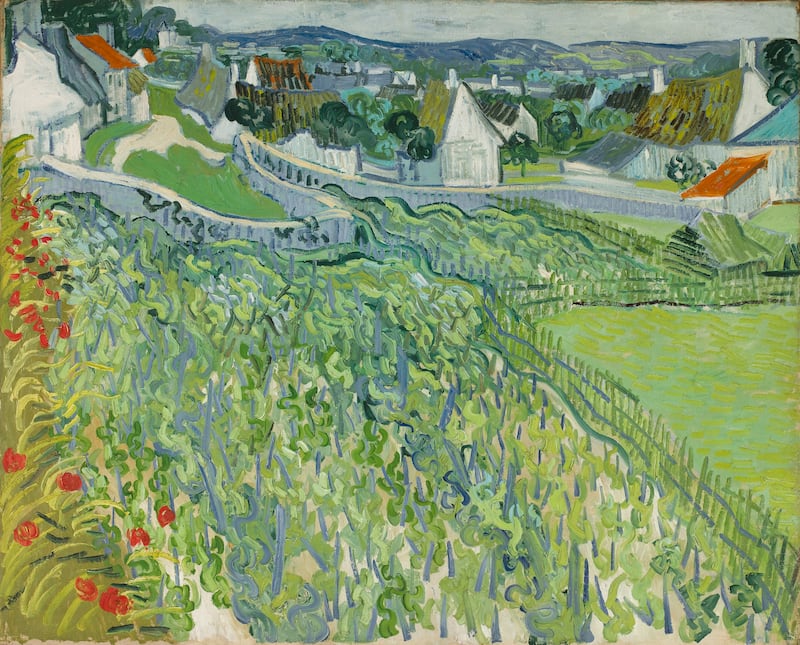
Most of Van Gogh’s paintings from Auvers are of seemingly inanimate landscapes, yet they convey kinetic energy. In Thatched Cottages in Cordeville, the sky and trees writhe in agitation. Crops seem to cascade down the terraced hillside. Red poppies border the shimmering, dancing vineyard that takes up two-thirds of another canvas. Nothing could be more static than flower beds in a garden, yet under Van Gogh’s brush they become teeming Petri dishes of coloured dots and dashes, inspired by the Japanese prints he collected.
“I already feel that it did me good to go south the better to see the north,” Van Gogh wrote to Theo and Jo when he arrived in Auvers. He was, he said, “more sure of my paintbrush than before I went to Arles”.
Between June 20th, 1890, and his death, on July 29th that year, Van Gogh painted 13 “double square” canvases, each 100cm long by 50cm high. The unusual format creates a panoramic view. Van Gogh may have intended to group the paintings in a frieze or exhibition. The Paris show has brought together 11 of the 13 double squares, which were one of the greatest innovations of Van Gogh’s career.
Van Gogh painted Wheat Field with Crows three weeks before his death. He described it in a letter on July 10th as “immense stretches of wheat under troubled skies”, adding that “I have not shied away from trying to express sadness, extreme solitude”. The painting, with its three vanishing points and flock of black crows, exudes anguish.
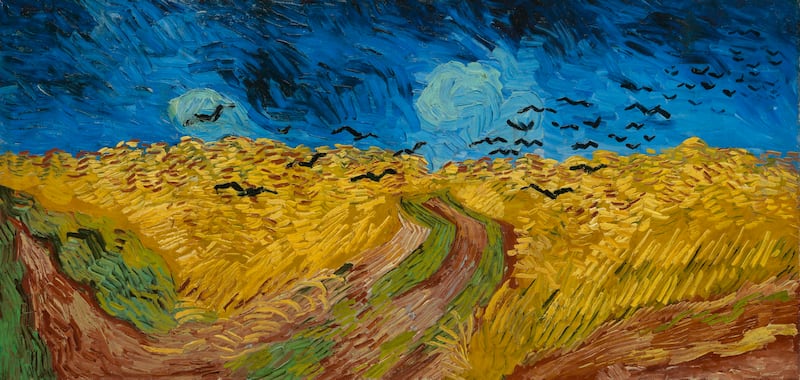
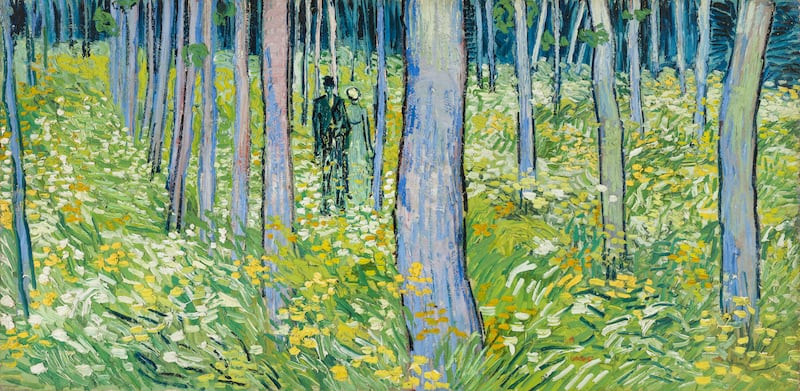
In Undergrowth with Two Figures, another double-square canvas, Van Gogh paints a couple walking in a forest of poplar trees, on a carpet of grass and wildflowers. He described it in a letter dated July 2nd: “Then undergrowth, violet trunks of poplars which cross the landscape perpendicularly like columns.”
Art historians interpret the totemic couple, whom Van Gogh does not mention in his description, as a sign of longing for the marriage and family that he never achieved.
Van Gogh’s romances were as disastrous as his attempts at salaried employment. In January 1882 Van Gogh met a homeless, pregnant alcoholic prostitute called Sien Hoornik. He took Sien, her mother and sister into his home. When her daughter was born he treated the child as his own. The brief relationship was the only domesticity Van Gogh ever knew.
Van Gogh painted his final picture, also in the double-square format, on July 27th, 1890. Tree Roots is a tightly framed close-up of gnarled roots and foliage, painted in Van Gogh’s favourite yellow, blue, green and rust colours, its surface textured by impasto.
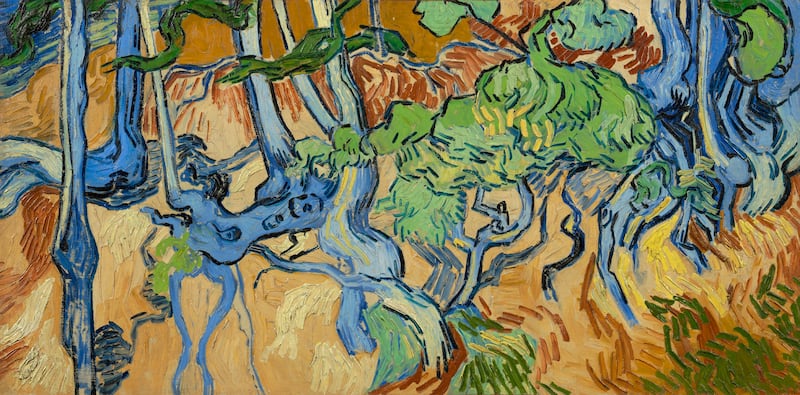
After painting Tree Roots, the artist went into a wheat field and shot himself in the chest. He staggered back to the Ravoux Inn and managed to climb the stairs to his garret room. Theo rushed to Auvers from Paris. Vincent wept in his arms, telling his brother it was “better for everyone” if his life ended. He died two days later; his last words to Theo were: “The sadness goes on forever.”
If he could own one Van Gogh painting, Coquery says, it would be Tree Roots, “because it was the last, because it is unique in Van Gogh’s oeuvre, at the same time abstract and extremely realistic, an almost psychoanalytical painting that summarises his journey on earth.”
Van Gogh was certainly tormented, but his poverty and lack of success have been exaggerated by popular legend. At the time of his death he was obtaining recognition.
In 1889 Monet saw several of Van Gogh’s paintings at the Salon des Indépendants, a show for avant-garde artists, and told Theo, “Your brother’s paintings are the best.” In January 1890 the magazine Mercure de France praised Van Gogh as the heir to Dutch Golden Age painters. Theo sold Van Gogh’s Red Vineyard for the tidy sum of 400 francs in February.
Van Gogh pulled painting toward abstract expressionism and had an incalculable influence on modern art. He became world famous in the early 20th century, thanks in large part to the efforts of Theo’s widow, Jo. His most expensive work, Orchard with Cypresses, sold for $117.2 million at Christie’s in New York in 2022. The Irish painter Sean Scully calls him “my beloved Vincent”.
Van Gogh’s story seems to confirm the popular belief that one must suffer to create art. Had the artist become rich and famous during his lifetime, I ask Coquery, would he have nonetheless painted masterpieces?
“I think he would have painted rubbish,” the curator replies. “I think that struggle was an integral part of his journey.”
A tour of Auvers-sur-Oise
“Orsay has the paintings, but we have Vincent,” says Wouter van der Veen, the curator of Van Gogh: The Last Journeys, at Château d’Auvers.
Van der Veen, a Dutch expert who also contributed to the new exhibition at the Musée d’Orsay, has made three important discoveries in as many years.
In 2020 he identified the barely changed gnarl of exposed roots, on Rue Daubigny in Auvers, that Van Gogh painted on the last day of his life, in July 1890. (He has published a book, Attacked at the Very Root, that is downloadable free of charge from his website, arthenon.com.)
In the attic of Dr Paul Gachet’s house, Van der Veen subsequently discovered the simple wooden frame that Van Gogh designed for his painting Thatched Cottages in Cordeville.
More recently, he found the exact place in the wheat fields where Van Gogh shot himself.
The exhibition that Van der Veen designed recounts Van Gogh’s physical, intellectual and artistic journeys. It is intended to complement, not compete with, the exhibition at the Musée d’Orsay. The slickly produced, comprehensive, multimedia biography re-creates Van Gogh’s family history, life experiences and oeuvre, taking account of the artistic movements that influenced him, including impressionism and Japanese prints. The museum has reconstructed the apartment in Montmartre that Van Gogh shared with his brother Theo, using a reproduction of the artist’s painting of the view over Paris as a window.
Insurance to borrow original Van Gogh paintings would have been prohibitively expensive, but the Van Gogh Museum in Amsterdam lent nine highly sophisticated museum editions, virtually indistinguishable from the originals, to Auvers for the exhibition. These include masterpieces created before Van Gogh’s stay in Auvers, including his much-loved Sunflowers and Blossoming Almond Tree, which he painted in February 1890 as a gift for Theo and his wife, Jo, to celebrate the birth of his nephew and namesake, Vincent Willem.
Van Gogh had fantasies of establishing an artists’ colony in Arles. Paul Gauguin was the sole painter who agreed to join him, and then only because Theo paid his way. Van Gogh and Gauguin argued bitterly about theories of painting. On the night of December 23rd, 1888, Van Gogh threatened Gauguin with a razor. Gauguin left the house they shared and never again saw Van Gogh, who used the razor to sever his own ear lobe. He bandaged his head, wrapped the ear in newspaper and delivered it to a 16-year-old prostitute as a gift.
After several more crises, Van Gogh checked himself into the Saint-Paul-de-Mausole asylum, in Saint-Rémy-de-Provence, the following May, at Theo’s expense.
Three hundred thousand tourists visit Auvers – population 7,000 – annually. Van der Veen admits that “there is always a danger of fetishism or pilgrimage”. Especially in Auvers, where Van Gogh feels present in the haunts he last visited 133 years ago.
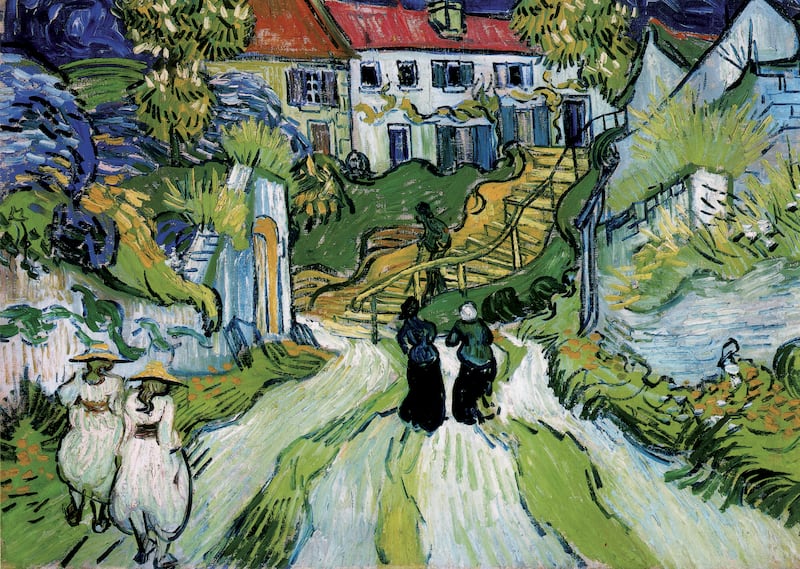
The steps leading up to Gachet’s house have not changed since Van Gogh climbed the hill from the train station on May 20th, 1890. The painter sat waiting for Gachet in the small diningroom to the right of the entry, his back to the south-facing window. Gachet described the afternoon sun flooding over Van Gogh’s head and shoulders. With his red hair, Gachet said, Van Gogh looked as if he was on fire.
A wooden panel in the salon across the hall still contains the nail from which Gachet hung the blue-green self-portrait that Van Gogh gave him, and that Gachet’s children later donated to the French state. Van Gogh painted Gachet’s daughter Marguerite playing the piano in the same room.
Auvers claims to be the cradle of impressionism. Cézanne, Pissarro and Renoir enjoyed lunches in Dr Gachet’s courtyard garden more than a decade before Van Gogh’s arrival.
On June 8th, 1890, Van Gogh met Theo, Jo and baby Vincent at the train station, taking a bird’s nest as a gift for his infant nephew. They spent a joyous afternoon at the same outdoor table where Gachet had welcomed the impressionists. It was probably the last happy moment of Van Gogh’s life.
When the artist visited Theo and Jo’s apartment in Paris a month later, he found the baby sick and Theo in poor health and in dispute with his employers about his taste for avant-garde art. Theo and Jo argued, and Van Gogh returned to Auvers dispirited. The downward spiral started.
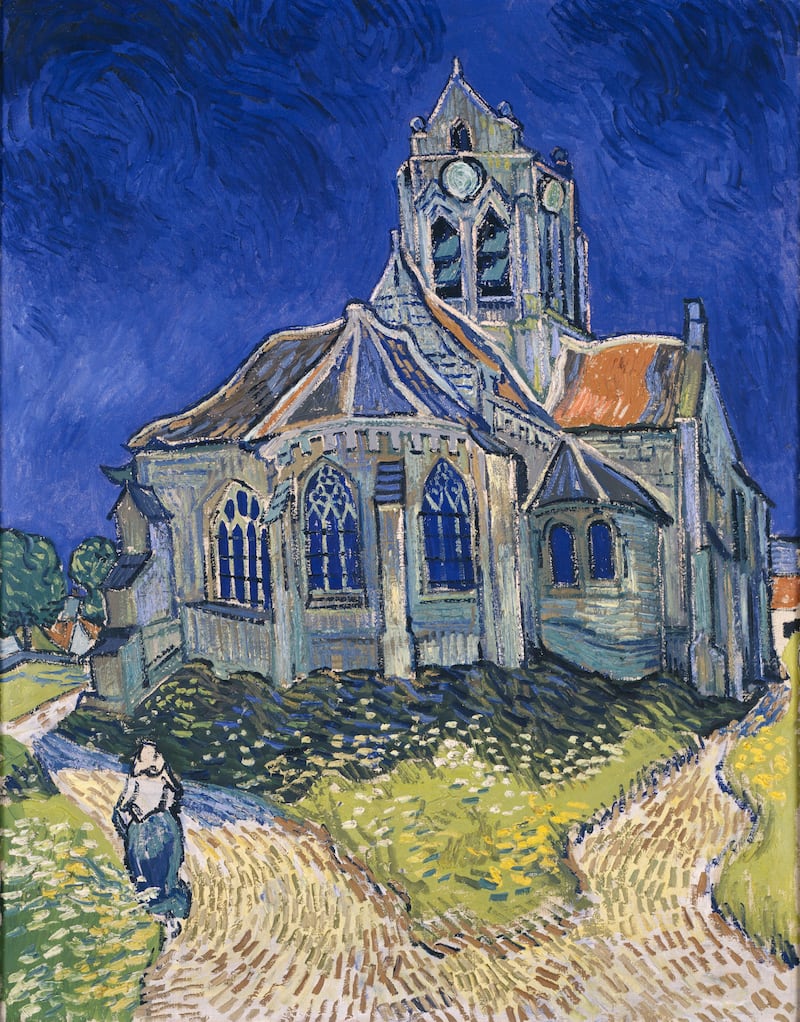

From Gachet’s house we head to Notre Dame de l’Assomption, which Van Gogh painted in early June 1890. Tourists make futile attempts to find the angle from which Van Gogh painted. He in fact moved his easel, Van der Veen explains, painting the edifice from several points of view, which endowed the canvas with a sense of movement.
The grey stone church is dull compared with Van Gogh’s brilliant palette. He boasted of using “expressive” and “sumptuous” colours for the church. “The building appears purplish against a sky of a deep and simple blue of pure cobalt, the stained-glass windows look like ultramarine blue patches, the roof is violet and in part orange,” he wrote. “In the foreground there is some flowering greenery and sunny pink sand.”
The town ends a few hundred metres beyond the church, where the road opens on to the high plain painted by Van Gogh. Vincent and Theo van Gogh lie side by side in the adjacent cemetery.
Cemetery custodians find letters, notebooks, paintbrushes and even the ashes of cremated art lovers strewn on Van Gogh’s tomb.
On a recent autumn day, a sheaf of sunflowers lay on the ivy covering the brothers’ graves. It was left that morning by Van Gogh’s great-grandnephew, Vincent Willem, and other family members.
Someone else had left a seashell, shaped for all the world like a human ear, atop Vincent’s simple tombstone.
Van Gogh in Auvers-sur-Oise: The Final Months is at the Musée D’Orsay, in Paris, until February 4th, 2024; Van Gogh: The Last Journeys is at Château d’Auvers, in Auvers-sur-Oise, until September 29th, 2024











